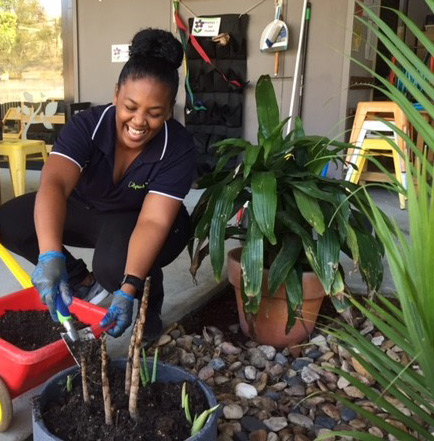Fun Activities & Games
Children’s Garden Fun – Encouraging Outdoor Time & Respect for Nature
Gardening is such a fun way to encourage outdoor time! It also nurtures in youngsters a love and respect for nature. We are delighted to have permission by the lovely Tonja du Toit of Citipointe Childcare Centre to share her wonderful story. Tonja invented the most amazing children’s garden FUN by encouraging her young charges to participate in their Garden Project. Read on to join in the fun!
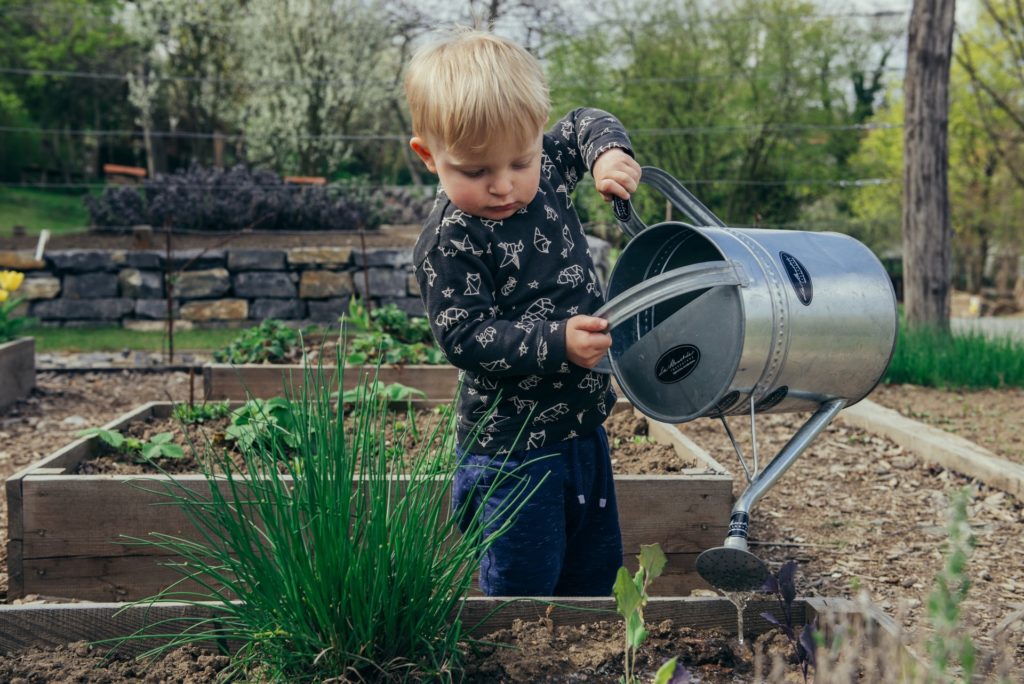
There is so much going on in our gardens!
Gardens allow for children to explore and also creates a learning environment. There are a variety of plants and other natural elements as well as some fun elements to stimulate curiosity.
The children also learn to respect nature and are doing an amazing job at being gentle with the plants and taking care of our gardens.
By playing together in the gardens, the children learn important social skills – to communicate, share, collaborate, have empathy with others, problem solving etc.
Sensory Garden:
This garden was made with sensory stimulation in mind.
Touch/feel:
- Aloe Vera – firm leaves with soft prickles
- Lambs ear – fluffy, fleshy round leaves
- African finger – firm, smooth and slender round leaves
- Celosia intense – dry and fluffy pom-pom flowers
- Grass types – thicker long blades and soft, fine blades
- Snail figurines – they have grassy shells to touch
There are different shapes and sizes and textures to find:
- Rocks are hard and smooth or rough
- The different seeds have different shapes and sizes; the cones feel knobbly: the Crow Ash seed pods are hard and prickly, the Screw Pine seeds are smooth and woody, etc.
Smell:
There are a range of different smells for the children to explore. We have the Marigold’s sharp, pungent smell and herbs such as Origanum, Lemon balm, Mint, Rosemary and Lavender.
See/visual:
- Bright, vibrant colours of the flowers such as petunias, marigolds, lobelias, portulacas, etc.
- Different shapes, sizes and colours of the leaves – flute shapes of the dwarf Rhoeo, hand shape leaves of the geranium, variation in tones of lighter and darker green, etc.
Hear:
- The gentle, smooth tones of bamboo wind chimes.
- Birds singing and fluttering around in the tree – birdfeeder lures the birds
Constructing the sensory garden:
First we had to prepare the soil. We used our own compost from the compost bin. The children helped to bring the compost to the garden area in their little wheelbarrows.
We added the soil and lots of eager little hands helped to spread the soil in the garden bed. We made holes and planted the flowers.
After all the plants were planted, we filled colourful watering cans and the children watered our new plants. We also added “worm juice” from our worm farm to the water to feed the new plants.
The children were very proud of their hard work and thought the garden looked “so pretty”.
The Koala 1 class also decorated a few planters to put up on the wooden edge of our garden. They prepared, planted and watered the planters by themselves using the little wheelbarrows, spades and watering cans.
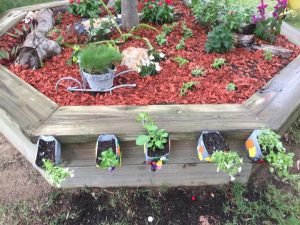
Other elements can also be found in the garden:
Birdhouse feeder and hanging decorations were made by upcycling items from thrift shops. The children love to put their little hands in the seed box to feel the seed running through their fingers.
They explore all seeds and the educator can show them how birds open the sunflower seeds shells to expose the soft kernel inside. Children learn to take care of animals.
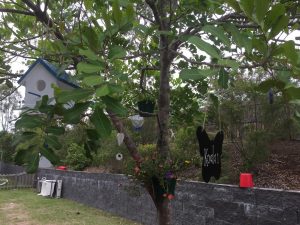
An old bowl made an ideal bird bath. Colourful painted stones around the bird bath for decoration and also the Fruits of the Spirit written on the stones.
The children would ask what it says and creates an opportunity to discuss spirituality with them and that they belong to the Christian family.
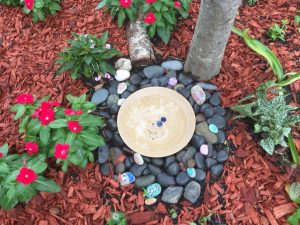
We also had a wonderful learning opportunity when Ms. Loren found a terrapin at the Childcare and we put him in the bird bath. After our terrapin friend left to find his friends in the creek, we bought a figurine of a turtle to remind us of him.
Seeing how much the children enjoyed the garden and coming to me to have little chats when I work there, I decided to make a few Emotion Plants to encourage the children to recognise their different emotions and to talk about how they are feeling.
Happy = bright flowers in orange pot.
Sad = tear shaped jelly bean succulent in blue pot.
Angry = prickly cactus in red pot.
Sick = grey coloured succulent in green pot.
For the Educators:
Let the children tell you the different textures they can feel. What is the difference between hard and soft, limp and firm? Let them smell and taste the herbs. Is it pleasant or bitter?
Children can point out and discuss their emotions by letting them choose an emotion pot plant. Example: why is the angry plant prickly? It means don’t touch me, I can hurt you. Why do you feel grey when you are sick?
Make connections between colours and feelings. This is the ideal opportunity to support individual children and to understand their uniqueness, creating a sense of being.
Let the children make planters or decorate items to put in the garden. They can plant their own plants. Let them water the garden using different methods: hose, watering cans, recycled milk containers etc.
There are endless teaching opportunities regarding plants, nature, sensory, animals, insects, creating, growing, caring etc.
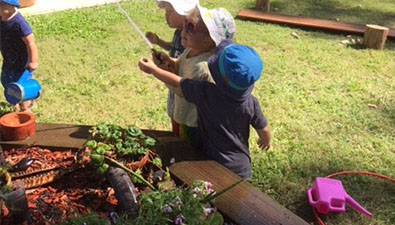
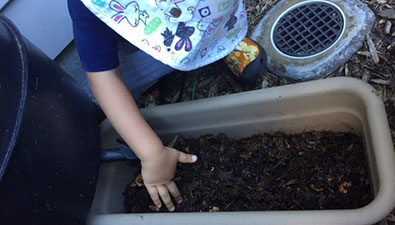
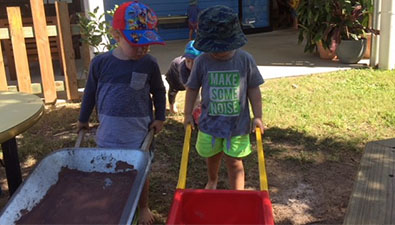
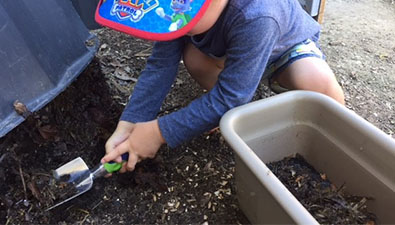
Fantasy Garden:
This garden was designed to target imagination and to encourage a sense of fantasy. The garden has a lot of small detail the children can explore.
The interesting objects in the garden sparks a lot of questions from the children which allows the educators to introduce the children to fantasy stories.
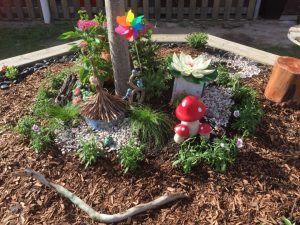
The children also learn to respect their special garden by not breaking the fairy houses and plants etc. They are allowed to touch the stones, rocks, cones, seeds and tree stumps that is lying around the edges.
They can also gently touch the delicate, small flowers on the plants. Children learn the BALANCE between more rough touching and delicate touching. As they extend their knowledge and understanding, they are becoming more skilled and confident.
Children learn about insects and birds that visit the garden. They learn new colours and shades of colours – light green, dark green etc. They learn about comparison – different sizes, textures etc.
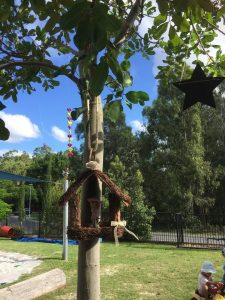
Constructing the garden:
The area was cleaned of all weeds and grass. I mixed garden soil with our own compost from the compost bin.
The fairy houses were made by upcycling items from thrift shops and bits and pieces of what was available for example twigs, leaves, scrap materials, craft items etc.
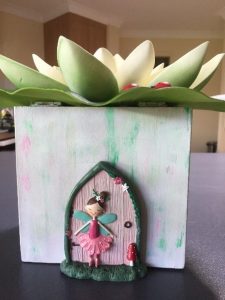
The idea was to create a fantasy forest effect. I used cones, branches, moss, toadstools, ponds with bridges etc.
I used plants with small flowers to emphasize the feeling of a fairy atmosphere. The names of the plants also defines the space: Fairy Lights, Jocelyn’s Pink and white and Mad Hatter.
For the Educators:
Great opportunity to teach children gentle touching and taking care of something. The fantasy element creates opportunity for imaginative story telling. Encourage children to make up their own stories.
Give the fairies names. Let them water the garden. They can tap worm juice to give to the plants as super food to make it grow. Learn about structures – why do we need bridges?
Discuss the materials the fairy houses are built with. Teach them new words for example – toadstools, ponds, ladybirds, dwarfs, elves, enchanted etc.
Our Little Play Garden:
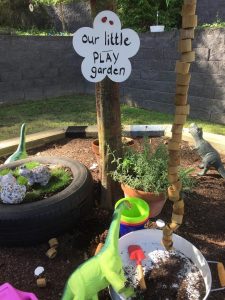
The idea for this garden was to allow the children to become more actively involved with their surroundings.
There is a range of different ways for the children to interact through play. Natural elements, as well as fun elements, were used to create a friendly, inviting play area.
Messy play:
- The soil and water allows the children to get creative in a fun way
Sensory awareness:
- Touch: the different elements of touch can be found in the textures of the seeds, cones and rocks in the garden; the soft, fine grass in the tyre; the textures on the tortoise and frog.
- Smell: the lavender, mint and rosemary plants allows for different fragrances to smell.
- See: the tree decorations allow for visual stimulation – sun-catcher, colourful birdhouse, beads, flowers etc.
- Hear: the bamboo chimes make a lovely soothing sound for the children to hear. Birds singing.
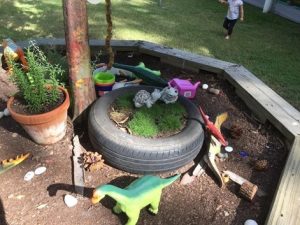
Sensory motor benefits: Various different textures can be found in the garden.
- Gross motor – kneeling, bending, stretching to reach things. Carrying of watering cans.
- Fine motor – handling the small seeds, picking small leaves etc.
- Coordination – using garden tools with both hands, digging a hole. Hand-eye coordination
- Balance – avoid stepping on the rocks, plants. Walking on the edge of the wooden garden bed.
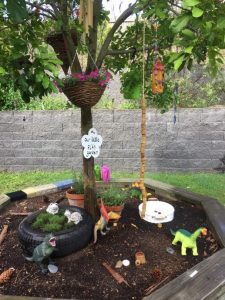
Exploring/adventure: this is obtained by all the different natural elements and toy dinosaurs. The children love to make roar sounds and also to put the dinosaurs into the water to drink and bath. Playing with the dinosaurs in a natural environment stimulates imagination.
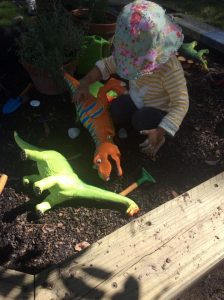
Learning through play: The colourful planter box with fake flowers and plants allows the children to do hands-on gardening. They use the small garden tools and colourful plastic pots to explore digging and planting.
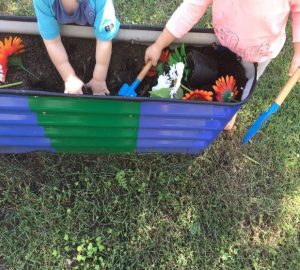
Small tree stumps and bamboo pieces can be stacked upon each other. Sticks can go through the holes in the bamboo pieces. The cone can balance on the flat rock.
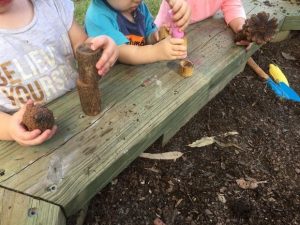
By feeding the birds the children also learn to take care of nature and learn about different animals and insects.
The Cubby House:
A funny mirror and chalkboards were added to the cubby house. The educators made the area fun and colourful with various colourful, inviting elements. This little area is now a zone where the children can let their imagination run wild.
The connection to space and environment directly and indirectly contributes to the way they learn. By having their own little area they also learn independence and a sense of belonging.
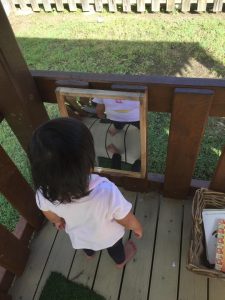
Constructing the garden:
A lot of elements can be found hanging on the tree branches. The soil under the tree was cleared of dry leaves and weeds. The soil was thoroughly raked to make it even.
Plants were placed in pots and in a tyre around the tree trunk – upcycling. Various natural elements such as rocks, seeds, cones, bamboo etc. were scattered around on the ground.
Toy dinosaurs were added to stimulate the children’s curiosity and to invite them to play in the garden – finding more treasures on the ground with closer inspection.
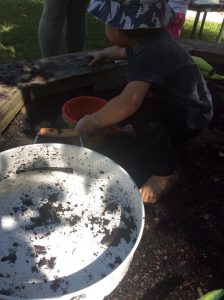
For the Educators:
Encourage children to be actively involved in the garden by letting them water the garden themselves. Give them birdseed to feed the birds. Keep them interested by adding different natural elements in the garden to find – different shaped dry leaves, seeds, flowers etc.
Let them dig for interesting objects in the planter box – small things to pick out of the soil. Great for fine motor skills and hand-eye coordination. Bring in wheelbarrows and let them fill it with different garden elements.
Take them on a little incursion to the worm farm to collect worm juice for the plants. Let them touch the worms. Teach them that we feed the leftover fruit and vegetables to the worms.
Show them the big compost bins and how we can use paper, leaves, cut grass and leftover organic materials to make compost.
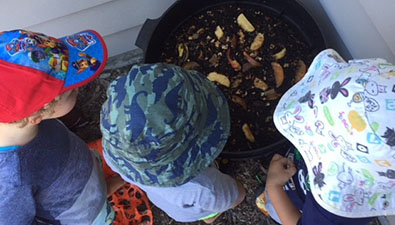
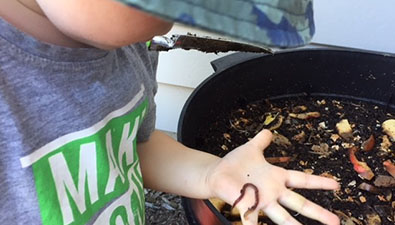
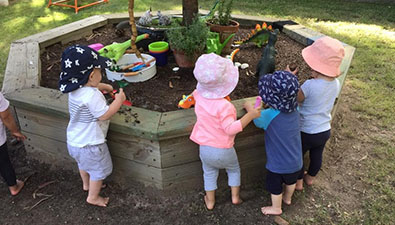
What is Next?
Our outdoors area has endless possibilities and room for growth. Educators can incorporate their own ideas to create learning areas and play areas.
Ms. Nicole and Ms. Naomi started their beautiful forest garden. Ms. Nicole worked very hard to clean up the area and prepare the ground for new plants.
The children helped with clearing away the stones and putting it back after the area was cleaned up. They love to be involved in creating new areas and they participate with great enthusiasm.
